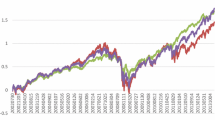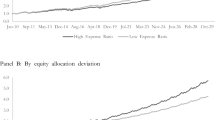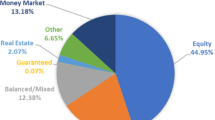Abstract
To evaluate the efficiency of target-date funds (TDFs), one of the fastest growing lines of mutual funds, we take 36 TDF series offered in the market and calculate investors’ welfare loss from TDF investment. We divide welfare loss into two categories: loss from suboptimal risky portfolio and loss from inappropriate glide path. We find that inappropriate glide path constitutes the major source of TDF performance inefficiency. This inefficiency could reduce an investor’s annual consumption by up to 17 per cent. We also find that the substantial heterogeneity in TDF performance is primarily caused by variation in glide paths. The heterogeneity contradicts the notion that one TDF fits everyone and it confirms the urgency to match TDF selection to investors’ risk profiles. In this spirit, we advocate a risk-based selection strategy as a remedy for TDF inefficiency. We estimate that this strategy could reduce approximately half of the welfare loss suffered from other commonly used strategies.


Similar content being viewed by others
Notes
Out of 277 funds in our sample, we were only able to obtain return data on 239 funds.
References
Agnew, J.R., Szykman, L.R., Utkus, S.P. and Young, J.A. (2011) What People Know about Target-Date Funds: Survey and Focus Group Evidence. Chestnut Hill, MA: Financial Security Project. FSP Working Paper no. 2011–2.
Balduzzi, P. and Reuter, J. (2012) Heterogeneity in Target-Date Funds and the Pension Protection Act of 2006. Cambridge, MA: National Bureau of Economic Research.NBER Working Paper no. 17886.
Bodie, Z. (2003) Thoughts on the future: Life-cycle investing in theory and practice. Financial Analysts Journal 59 (1): 24–29.
Bodie, Z. and Crane, D.B. (1997) Personal investing: Advice, theory, and evidence. Financial Analysts Journal 53 (6): 13–23.
Bodie, Z., Merton, R.C. and Samuelson, W.F. (1992) Labor supply flexibility and portfolio choice in a life cycle model. Journal of Economic Dynamics and Control 16 (3–4): 427–449.
Bodie, Z. and Treussard, J. (2007) Making investment choices as simple as possible, but not simpler. Financial Analysts Journal 63 (3): 42–47.
Bridges, B., Gesumaria, R. and Leonesio, M.V. (2010) Assessing the performance of life-cycle portfolio allocation strategies for retirement saving: A simulation study. Social Security Bulletin 70 (1): 23–43.
Bruder, B., Culerier, L. and Roncalli, T. (2012) How to Design Target-Date Funds? Paris, France: Lyxor Asset Management. The Lyxor White Paper no. 9.
Campbell, J.Y., Cocco, J.F., Gomes, F.J. and Maenhout, P.J. (2001) Investing retirement wealth. In: J.Y. Campbell and M. Feldstein (eds.) Risk Aspects of Investment-Based Social Security Reform, Chicago: University of Chicago Press.
Cardak, B.A. and Wilkins, R. (2009) The determinants of household risky asset holdings: Australian evidence on background risk and other factors. Journal of Banking & Finance 33 (5): 850–860.
Cocco, J.F., Gomes, F.J. and Maenhout, P.J. (2005) Consumption and portfolio choice over the life cycle. The Review of Financial Studies 18 (2): 491–533.
Gomes, F.J., Kotlikoff, L.J. and Viceira, L.M. (2008) Optimal life-cycle investing with flexible labor supply: A welfare analysis of life-cycle funds. American Economic Review: Papers & Proceedings 98 (2): 297–303.
Horneff, W., Maurer, R.H. and Rogalla, R. (2010) Dynamic portfolio choice with deferred annuities. Journal of Banking & Finance 34 (11): 2652–2664.
Investment Company Institute (2011) 2011 investment company fact book, http://www.ici.org/pdf/2011_factbook.pdf, accessed 1 April 2015.
Israelsen, C.L. and Nagengast, J.C. (2012) Popping the hood V, 2012. An analysis of target date fund families, https://www.americancentury.com/pdf/Popping_the_Hood_Study_2012.pdf, accessed 21 April 2014.
Jagannathan, R. and Kocherlakota, N.R. (1996) Why should older people invest less in stocks than younger people? Federal Reserve Bank of Minneapolis Quarterly Review 20 (3): 11–23.
Mitchell, O.S. and Utkus, S.P. (2012) Target-Date Funds in 401(k) Retirement Plans. Philadelphia, PA: Pension Research Council. Pension Research Council Working Paper no. 2012–02.
Morningstar (2011) Target-date series research paper: 2011 industry survey, http://corporate.morningstar.com/us/documents/MethodologyDocuments/MethodologyPapers/Target_Date_Industry_Survey_2011.pdf, accessed 5 March 2014.
Morningstar (2013) Target-date series research paper 2013 survey, http://corporate.morningstar.com/us/documents/ResearchPapers/2013TargetDate.pdf, accessed 5 March 2014.
Pang, G. and Warshawsky, M. (2011) Target-date and balanced funds: Latest market offerings and risk-return analysis. Financial Services Review 20 (1): 21–34.
Poterba, J., Rauh, J., Venti, S. and Wise, D. (2009a) Lifecycle asset allocation strategies and the distribution of 401(k) retirement wealth. In: D. Wise (ed.) Developments in the Economics of Aging, Chicago: University of Chicago Press.
Poterba, J., Rauh, J., Venti, S. and Wise, D. (2009b) Reducing social security PRA risk at the individual level-lifecycle funds and no-loss strategies. In: J. Brown, J. Liebman and D.A. Wise (eds.) Social Security Policy in a Changing Environment, Chicago: University of Chicago Press.
Sandhya, V.V. (2010) Agency problems in target-date funds, http://ssrn.com/abstract=1570578, assessed 21 April 2014.
Schroder, D. (2013) Asset allocation in private wealth management: Theory versus practice. Journal of Asset Management 14 (3): 162–181.
U.S. Government Accountability Office (2011) Defined Contribution Plans-Key Information on Target Date Funds as Default Investments Should be Provided to Plan Sponsors and Participants. Washington, DC: GAO Report to Congressional Requesters GAO-11-118.
U.S. Dept. of Labor (2012) Private Pension Plan Bulletin: Abstract of 2010 Form 5500 Annual Reports. U.S. Department of Labor Employee Benefits Security Administration, Washington DC.
VanDerhei, J., Holden, S., Alonso, L. and Bass, S. (2012) 401(k) Plan Asset Allocation, Account Balances, and Loan Activity in 2011. Washington, DC: Employee Benefit Research Institute Brief Issue no. 380.
Viceira, L.M. (2008) Life-cycle funds. In: A. Lusardi (ed.) Overcoming the Saving Slump: How to Increase the Effectiveness of Financial Education and Saving Programs, Chicago: University of Chicago Press.
Yoon, Y. (2010) Glide path and dynamic asset allocation of target date funds. Journal of Asset Management 11 (5): 346–360.
Author information
Authors and Affiliations
Corresponding author
Additional information
2received his PhD in Operations Management from Kenan-Flagler Business School at the University of North Carolina at Chapel Hill. He is an Assistant Professor of Decision Science at the University of San Diego. His research focuses on asset management and supply chain management.
Appendices
Appendix A
Appendix A Numerical solution method
Our dynamic programming model was solved using backward induction. The state variables in each period (age) include the cash-on-hand at the beginning of each period and the transitory shock. In the last period, the agent simply consumes all cash-on-hand and generates the value function from that consumption. This value function is then used to compute the policy rules, and the corresponding value function, for the previous period. This process is carried out from the last period to the first period.
We obtained the optimal decision variables (consumption and portfolio allocation) in an unconstrained problem using Nelder-Mead method. When the unconstrained solution generated by Nelder-Mead method is infeasible, we applied a standard grid search to the constrained problem. We also applied standard grid search in several fund family and confirmed that Nelder-Mead method generates global optimal. Then Nelder-Mead is used throughout all of the remaining fund families for computational efficiency. The state-space was discretized using power grid in which the ratio of two adjacent state variables equals to a chosen power parameter. The upper and lower bounds for state-space were chosen to be non-binding in all periods. Gauss–Hermite quadrature method is used to approximate the density functions for innovation to excess stock returns, labor income shock and transitory shocks to perform numerical integrations. In evaluating the value function that corresponds to state variables that do not lie in the chosen grid points, we used a cubic spline interpolation in the log of the state variables.
Appendix B
Estimating TDF risky portfolio return moments
To compute return moments of risky portfolios under each TDF, we adopt the CAPM asset pricing model and regress the excess return of each equity asset under the TDFs on market portfolio – S&P 500 index:

where R
i,t
is the excess return for equity asset i at time t; MKT is the excess return for S&P 500. The time period for regression is 1997/1–2010/7(or less if not available for some equities). Using the estimated risk loading  from the regression above, we can estimate moments for each equity asset as:
from the regression above, we can estimate moments for each equity asset as:  where
where  is the vector of estimated mean excess return over all equity assets;
is the vector of estimated mean excess return over all equity assets;  is the estimated variance-covariance matrix of excess returns over all equity assets;
is the estimated variance-covariance matrix of excess returns over all equity assets;  and
and  are the mean excess return and variance of market portfolio (S&P 500); and
are the mean excess return and variance of market portfolio (S&P 500); and  is the idiosyncratic risk estimated from the variance-covariance matrix of regression residuals ɛ
i,t
.
is the idiosyncratic risk estimated from the variance-covariance matrix of regression residuals ɛ
i,t
.
Now, based on the estimated mean and variance of returns over all equity assets, we estimate moments of risky portfolio in each TDF:


where ω is the weight vector over individual equity assets in the risky portfolio of a particular TDF fund. The risky portfolio return is adjusted for TDF expense e p . Last, the average risky portfolio returns and standard deviations across all TDFs in one series is used as the return-risk measures for risky portfolio in that TDF series.
Rights and permissions
About this article
Cite this article
Tang, N., Lin, YT. The efficiency of target-date funds. J Asset Manag 16, 131–148 (2015). https://doi.org/10.1057/jam.2015.8
Received:
Revised:
Published:
Issue Date:
DOI: https://doi.org/10.1057/jam.2015.8




